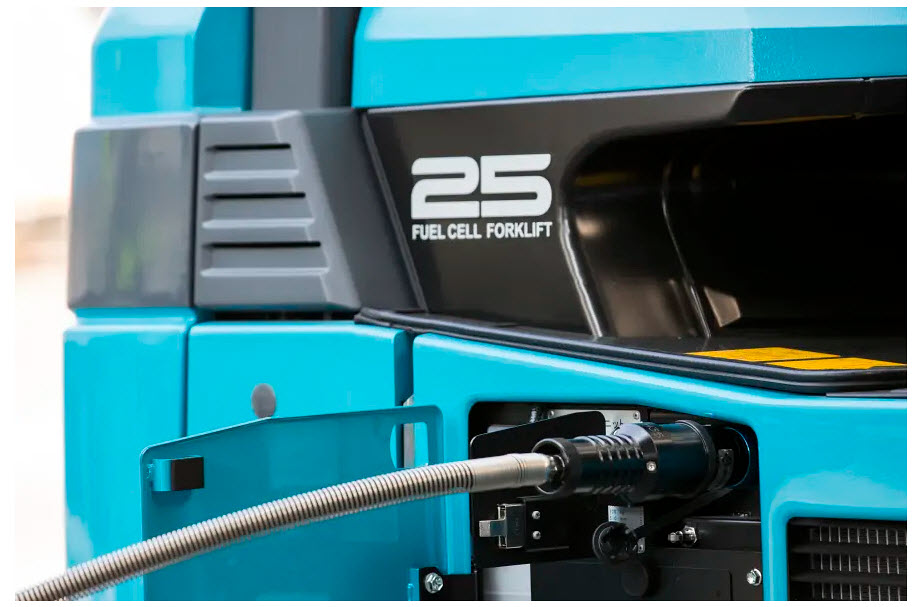
Fuel cell forklifts are an interesting alternative to conventional drives – CIN study sheds light on the potential market
More than 25,000 fuel cell-powered trucks are already in commercial use in the US. In Europe, on the other hand, only around 500 of these environmentally friendly intralogistics devices drive-through warehouses. But that should change quickly. The reasons for this are shown in the new CIN study, which explores market potentials and evaluates different drive types with regard to different application scenarios.
The study “Material Handling – Market Analysis / Market Potential of Fuel Cells in Intralogistics” was commissioned by CIN by LBST (Ludwig-Bölkow-Systemtechnik) and coordinated by the National Organization for Hydrogen and Fuel Cell Technology (NOW).
Hydrogen-powered industrial trucks are in competition with older drive technologies. According to CIN, around 70,000 internal combustion engine models (class 4/5) are sold annually in Europe in the segment of counterbalanced trucks. In addition, there are about 60,000 to 80,000 industrial trucks with traditional lead-acid batteries and an increasing number of devices with lithium-ion batteries. Against these types, the fuel cell occurs.
A glimpse into the US provides clues as to where the new drive might first find a market. In 2016, about 171,000 class 1 to 3 material handling vehicles were dropped from the ant to the normal forklift, of which about 4,000 were fuel cells, which corresponds to a share of 2.3 percent. That would be 8,000 fuel cell trucks per year in Europe.
The automotive industry, which faces the challenge of a switch to e-mobility, offers particular potential for the introduction of fuel cell industrial trucks. According to their own statements, the medium-term potential for fuel cells in intralogistics in the production plants is up to 30 percent of the fleet of industrial trucks. This offers high synergy potential for the use of the required hydrogen infrastructure also for fuel cell trucks.
A comparative full-cost calculation shows that fuel cell units are economically advantageous, especially where larger fleets with high capacity utilization are used. The study shows that some site- and company-dependent parameters have a significant impact on the fuel cell truck fleet’s profitability over pure battery drives. When calculating economic efficiency, state support for environmentally friendly technology should not be forgotten.
From a technical point of view, fuel cell trucks combine the advantages of pure battery vehicles such as unrestricted use in enclosed spaces with the advantages of internal combustion engine devices, ie above all high capacity utilization, high performance, continuous performance level, fast refueling.
Hydrogen trucks are much more environmentally friendly than their competitors with diesel engines. This helps to protect the climate through decarbonization and the reduction of air pollutants and noise emissions. Companies can use hydrogen propulsion to prepare for upcoming state regulations, but also proactively improve their sustainability record and thus maintain their image. The environmental footprint is about equivalent compared to lead-acid batteries. A comparison with lithium-ion batteries is still pending.
According to the manufacturers, from the point of view of their potential customers, there are no fundamental obstacles to the introduction of fuel cell forklift trucks. They are deliverable in most size classes – only from the 4- to 5-t class, there are still problems.
An increasing number of players are working on establishing a necessary infrastructure for hydrogen supply. The car industry and its customers need petrol stations, as do the first railway companies. In addition, steel and petroleum industries need more hydrogen. Thus, the costs of green fuel for intralogistics are likely to decline.
Also interesting are the developments in the field of fuel cell trucks because users can experience synergies in the form of a shared infrastructure, for example on the company premises. One of the first examples is the distribution center Trondheim of the Norwegian trading group Norgesgruppen with its logistics division Asko. It generates the hydrogen at the site and uses both forklifts and Scania trucks there.
The study sees two strong motivations that could boost the number of fuel cell trucks: higher productivity and the associated savings in equipment. On the other hand, the necessary replacement of forklifts with combustion engines for use scenarios in which battery vehicles do not bring the necessary power or have other disadvantages.
The study calls for increased industrialization of the segment, especially for fuel cell systems, but also for the entire value chain. This should drive further commercialization and increase profitability.
An important part of such industrialization must be more competition along the entire value chain. Further demands: The product range of battery devices, which are prepared as “H2-ready” for fuel cells, must grow. The technology needs to be more standardized. The hydrogen production costs must go down.
Source: Wolfgang Axthammer, Lebensmittelzeitung, IT & LOGISTICS, Issue 37, September 13, 2019
Read the most up to date Fuel Cell and Hydrogen Industry news at FuelCellsWorks




